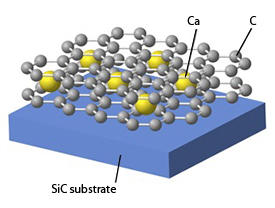

02/25/2013

Reproduced from Ref. 1 © 2012 K. Kanetani et al.
Graphene has a well-earned reputation as a ‘wonder material’. Isolation of these one-atom-thick sheets of carbon that make up graphite — a material best known for its use in pencils — has opened an avenue for the study and utilization of two-dimensional materials. Bulk graphite has also attracted interest in its own right, especially for its potential practical applications. In particular, the insertion of substances between its graphene layers to form ‘graphite intercalation compounds’ (GICs) has been investigated as a method for the storage of lithium atoms within batteries. Interestingly, some GICs can also conduct electricity without any resistance — an attractive phenomenon known as superconductivity.
Now, by trapping calcium atoms between just two layers of graphene, Katsuaki Sugawara and co-workers from the AIMR and the Department of Physics at Tohoku University have constructed a carbon-based superconductor at its two-dimensional limit1 (see image). Their ‘sandwich’ material offers the advantages of bulk graphite while being as thin as it can possibly be. With the production of this graphene–calcium material, the researchers have constructed the thinnest possible form of the calcium-based GIC C6Ca.
Among the known superconducting GICs, C6Ca is arguably the most interesting as it develops superconductivity at a higher temperature than any other. Sugawara and co-workers were able to reduce the thickness of the graphite layer that surrounds the calcium atoms to the absolute minimum. The thin graphene–calcium–graphene material was produced by first introducing lithium into a bilayer graphene film supported by a silicon carbide (SiC) substrate — a less challenging task than the direct introduction of calcium, due to the smaller size of the lithium atoms. Subsequently, they replaced the intercalated lithium atoms by depositing calcium onto the graphene–lithium–graphene intermediate, followed by heating. “We had initially developed this method for making millimeter-thick C6Ca, and have now improved it for use in bilayer-graphene films,” explains Sugawara.
Despite the thinness of the material they created, the scientists were able to successfully perform a number of experiments on it. “The most important result of our study is the characterization of the electronic structure in this thinnest limit of a GIC,” notes Sugawara. “Our findings should form a basis for understanding superconductivity in GIC systems.” The team now hopes that the same approach will be useful for other GIC applications, including the creation of efficient microbatteries. “This research area should help to gain a fundamental understanding of the physics and chemistry relevant to state-of-the-art batteries using graphite as an electrode,” says Sugawara.
Kanetani, K., Sugawara, K., Sato, T., Shimizu, R., Iwaya, K., Hitosugi, T. & Takahashi, T. Ca intercalated bilayer graphene as a thinnest limit of superconducting C6Ca. Proceedings of the National Academy of Sciences USA 109, 19610–19613 (2012). | article
This research highlight has been approved by the authors of the original article and all information and data contained within has been provided by said authors.